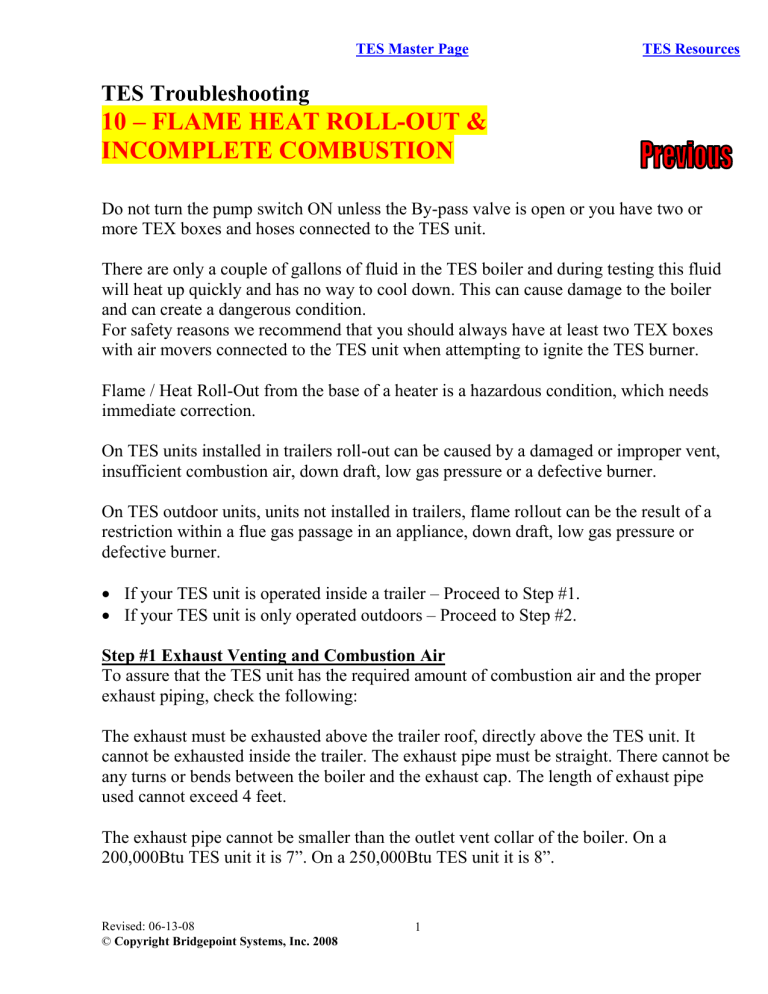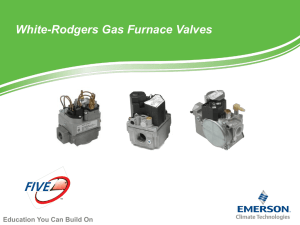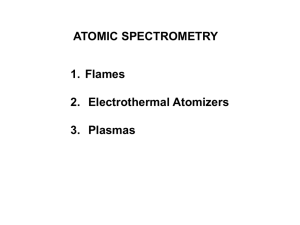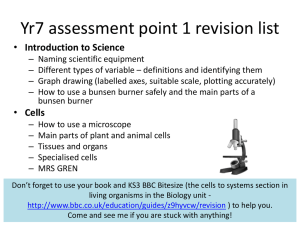FLAME ROLL-OUT - INCOMPLETE COMBUSTION

TES Master Page TES Resources
TES Troubleshooting
10 – FLAME HEAT ROLL-OUT &
INCOMPLETE COMBUSTION
Do not turn the pump switch ON unless the By-pass valve is open or you have two or more TEX boxes and hoses connected to the TES unit.
There are only a couple of gallons of fluid in the TES boiler and during testing this fluid will heat up quickly and has no way to cool down. This can cause damage to the boiler and can create a dangerous condition.
For safety reasons we recommend that you should always have at least two TEX boxes with air movers connected to the TES unit when attempting to ignite the TES burner.
Flame / Heat Roll-Out from the base of a heater is a hazardous condition, which needs immediate correction.
On TES units installed in trailers roll-out can be caused by a damaged or improper vent, insufficient combustion air, down draft, low gas pressure or a defective burner.
On TES outdoor units, units not installed in trailers, flame rollout can be the result of a restriction within a flue gas passage in an appliance, down draft, low gas pressure or defective burner.
If your TES unit is operated inside a trailer – Proceed to Step #1.
If your TES unit is only operated outdoors – Proceed to Step #2.
Step #1 Exhaust Venting and Combustion Air
To assure that the TES unit has the required amount of combustion air and the proper exhaust piping, check the following:
The exhaust must be exhausted above the trailer roof, directly above the TES unit. It cannot be exhausted inside the trailer. The exhaust pipe must be straight. There cannot be any turns or bends between the boiler and the exhaust cap. The length of exhaust pipe used cannot exceed 4 feet.
The exhaust pipe cannot be smaller than the outlet vent collar of the boiler. On a
200,000Btu TES unit it is 7”. On a 250,000Btu TES unit it is 8”.
Revised: 06-13-08
© Copyright Bridgepoint Systems, Inc. 2008
1
The exhaust cap cannot be smaller than the exhaust pipe size. On a 200,000Btu TES unit it is 7”. On a 250,000Btu TES unit it is 8”.
The exhaust cap on the trailer roof must be designed to allow the exhaust to be removed with the wind blowing in any direction. The outdoor vent cap cannot be installed on the trailer roof or used during trailer operation.
When connecting the exhaust pipe to the TES boiler and exhaust cap. The crimped end of the lower item must fit inside the un-crimped opening of the upper item. This means that the crimped outlet vent collar on top of the boiler is inside the exhaust adapter/reducer.
The crimped end of the adapter/reducer fits inside the exhaust pipe and the crimped end on the exhaust pipe fits inside the exhaust cap.
The TES unit cannot be operated with the trailer doors open. This disrupts the air flow circulation that provides combustion air and helps create the draft that removes the exhaust.
Vent fans cannot be used. The TES boiler cannot be exposed to negative air pressure.
An incoming air fan must be running at all times the TES is operated inside the trailer.
The incoming air fan must be located with 12” of the floor. The air flow of the fan cannot exceed 700cfm.
Roof vents must have a minimum total unrestricted open air space of 200 square inches for 200,000Btu units and 250 square inches for 250,000Btu units.
To keep the control panel cooler, the control panel door can be left open when operating the TES unit inside a locked trailer.
If you found and corrected a problem in the exhaust venting or combustion air supply you may have corrected the problem. Once these requirements have all been met you have eliminated the majority of the conditions that lead to flame or heat roll-out, but there may be other causes. For other possible causes to be checked proceed to Step #2.
Step #2 Flue Gas Restriction
Appliances such as TES, with multiple burners positioned beneath sectional heat exchanger passages, are particularly susceptible to this problem. The most commonly found causes of restricted flue gas passages are soot and rust. The heat exchangers must be inspected to determine if they are restricted and corrective actions taken to protect
TES from flame or heat roll-out.
Rust from degrading heat exchanger surfaces can accumulate in the narrow portions of a passage and impede the flow of combustion byproducts out of the appliance.
Revised: 06-13-08
© Copyright Bridgepoint Systems, Inc. 2008
2
Soot can be produced from any gas combustion that occurs without a proper air/fuel mix.
Yellow flames in a gas appliance indicate an impaired combustion process and warn soot may be accumulating. Dirty jets, worn or wrong size jets or dirty or damaged burners are the usual causes of heat exchanger passages restricted with soot, although the introduction of liquid propane into the system by overfilling the propane tanks can also cause this problem.
A restriction in a passage through a heat exchanger slows the flow of combustion byproducts out of the appliance. As the area required for flow diminishes, combustion byproducts begin to collect in the combustion area. These accumulated byproducts deprive the gas flame of the air required to support combustion. The air starved combustion process causes the flame to lift and appear to float above the burner. The size of the restriction will control how long the burner can operate before flame movement occurs. If sufficient material has accumulated in the passage to severely restrict the flow of combustion byproducts, the flame will be forced to seek air at the opening of the burner area. This is the situation that causes fire to emerge from within the combustion area of the appliance, the condition called flame rollout.
The heat exchangers can be inspected by removing the burner drawer assembly and looking up at the heat exchangers using a mirror, or the back panels and flue collector box can be removed to access the heat exchangers from above.
The heat exchangers must be cleaned before returning the TES unit to service
Once you know the heat exchangers are clean, proceed to Step #3.
Step #3
A partially plugged pilot orifice, improperly adjusted pilot flame or inconsistent ignition spark can delay ignition and cause gas to flow out of the combustion chamber prior to ignition, causing damage similar to flame roll-out.
Turn off the propane tank valves. With the pump switch ON, turn the heater switch ON and test for power at the blue wire connected to terminal #6 of the burner ignition control.
This is the 24V input terminal. Use terminal #1 of the 24V terminal block as the neutral connection.
No voltage found – Go to TES 5 .
24 volts found – Retest using the gray wire connected to terminal #5 of the burner ignition control as the neutral connection. o 24 volts found – Continue with testing. o No voltage found – Repair or replace the gray wire as needed to restore the connection between terminal #1 of the 24V terminal block and terminal #5 of the burner ignition control and continue with testing.
Revised: 06-13-08
© Copyright Bridgepoint Systems, Inc. 2008
3
Examine the green wire ground connection between the burner drawer assembly and terminal #4 ground terminal of the burner ignition control. Repair or replace the wire as needed to assure a good connection between the burner ignition control and the burner ignition control.
Turn off the propane tank valves. With the pump switch ON, turn the heater switch ON
Observe the pilot assembly. Can you see a strong ignition spark?
Yes – Continue with testing.
No – Go to Step #3A.
Open the propane tank valves. Disconnect the brown wire from MV terminal of the Main
Gas Valve. (This will prevent the burner from lighting while the pilot light is tested.)
With the pump switch ON, turn the heater switch ON
Observe the pilot assembly during the ignition sequence. Does the pilot light?
No – Proceed to Step #3B.
Yes – Does the spark stop when the pilot lights? o Yes – Proceed to Step #3C. o No – Remove the pilot assembly. Replace the pilot assembly and retest.
If the spark stops when the pilot lights – Proceed to Step #3C.
If the spark does not stop when the pilot lights - Examine the pilot flame.
It should be blue, steady and envelopes 3/8” to 1/2” of the flame rod.
Flame looks blue & steady as described – Replace the burner ignition control. Reconnect the brown wire to the MV terminal on the Main Gas Valve and return to the beginning of Step #3.
Flame does not look as described – Refer to the pilot flame chart to correct pilot flame or contact your nearest service center for advice or assistance. Once pilot flame is blue & steady as described –
Reconnect the brown wire to the MV terminal on the Main Gas
Valve and return to the beginning of Step #3.
Step #3A Spark Ignition Circuit
Examine the orange ignition wire from the spark terminal of the burner ignition control down to the pilot assembly. Make sure there are no cuts or splices in the wire. The connections to the igniter and the burner ignition control must be clean and tight. Replace the pilot assembly if the wire is worn or damaged.
If you have not yet performed this test – Continue with this Step.
If you have previously completed this step and had spark, but the spark is not visible at the pilot assembly - The problem has to be a bad ground connection between terminal #4 and the burner drawer or a bad ignition wire on the pilot assembly.
Replace the pilot assembly and ground wire or contact your nearest service center for advice or assistance.
Revised: 06-13-08
© Copyright Bridgepoint Systems, Inc. 2008
4
To test the Spark Ignition Circuit you will need a short jumper wire made from spark plug wire or other heavily insulated wire.
WARNING!
The ignition circuit generates over 10,000 volts and electrical shock can result. Do not touch the stripped ends of the jumper wire and wear rubber gloves when performing this test.
Connect one end of the jumper wire to terminal # 4 ground terminal of the burner ignition control. Turn off the propane tank valves. With the pump switch ON, turn the heater switch ON and move the other end of the jumper wire towards the Spark terminal of the burner ignition control until a spark is created. Pull the jumper slowly away from the
Spark terminal and note the length of the gap when the sparking stops.
No spark or spark less than 1/8” – Replace the burner ignition control, reconnect the green wire to terminal #4 the ground terminal of the burner ignition control and return to Step #3
Spark 1/8” or longer - reconnect the green wire to terminal #4 the ground terminal of the burner ignition control and return to Step #3
Step #3B Pilot Gas
An incoming manifold pressure of 12-14” of water column must be maintained for proper operation of the burners and pilot. Before beginning to test the pressure, make sure the propane tank valves are closed. Connect a manometer to the inlet pressure tap port. Open the propane tank valves and check the pressure.
If the pressure is in the range of 12-14” WC – Continue with testing.
If the pressure is less than 12” WC or more than 14” WC – Adjust the regulator to set the pressure in the correct range. o If the pressure can be adjusted and set in the range of 12-14” WC – Continue with testing. o If the pressure cannot be adjusted to the correct range – Replace the regulator and return to the beginning of Step #3B. If you have already replaced the regulator check the POL fitting, valves and hoses for restrictions or contact your nearest distributor for advice or assistance.
Once the incoming pressure is set, disconnect the brown wire from MV terminal of the
Main Gas Valve. (This will prevent the burner from lighting while the pilot light is tested.) With the pump switch ON, turn the heater switch ON
Observe the pilot assembly during the ignition sequence. Does the pilot light?
Yes – Continue with testing.
No – Replace the pilot assembly and retest. o The pilot lights – Continue with testing. o The pilot does not light – Replace the main gas valve and return to Step #3.
Revised: 06-13-08
© Copyright Bridgepoint Systems, Inc. 2008
5
The pilot flame should envelope 3/8-1/2” of the flame rod. Keep the brown wire disconnected from the MV terminal of the main gas valve to prevent the burner from lighting during the pilot adjustment.
To adjust the pilot, remove the pilot gas screw cover located on the main gas valve. Turn the adjustment screw clockwise to decrease the flame size and counterclockwise to increase the flame size. When the flame adjustment is completed replace the screw cover and reconnect the brown wire to the MV terminal of the main gas valve.
If the flame is adjusted to the proper size – Return to Step #3
If the flame cannot be adjusted to the proper size – Clean or replace the pilot orifice and retest. o If the flame is adjusted to the proper size – Return to Step #3. o If the flame cannot be adjusted to the proper size – You may need to replace the main gas valve and/or the pilot assembly. Contact your nearest service center for advice or assistance.
Step #3C Burner Ignition
Reconnect the brown wire to MV terminal of the Main Gas Valve.
With the pump switch
ON, turn the heater switch ON to try to light the burner.
If the main burner lights – Proceed to Step #4.
If the main burner does not light – Check for power across the PV-MV/PV terminals on the burner ignition control. o Voltage found – Replace the main gas valve and return to Step #3 o No voltage found – Replace the Burner ignition control and return to Step #3.
Step #4
A defective gas valve, regulator or a restriction in the propane hoses or fittings may cause a drop in the pressure or flow that can prevent proper combustion. This can cause the propane combustion to occur inside the burner tube. This can damage the burner tube and pipe the heat outside of the combustion chamber to melt wires and other components.
Remove the burner drawer and inspect the burner tubes. Clean the burner tubes and replace the burner tubes if they are distorted or show signs of corrosion or other damage.
This is a good time to install a burner tube retaining strap if your unit does not already have one. The burner tube retaining strap will prevent the burner tubes from bouncing out of position during TES transportation. Remove the burner jets. Clean the jets and check the orifice diameter using a wire size drill bit.
#47 0-1999ft jets
#49 2000-3999ft jets
#50 4000-5999ft jets
#51 6000-8000ft jets
Revised: 06-13-08
© Copyright Bridgepoint Systems, Inc. 2008
6
Once the jets and burner tubes are cleaned or replaced, check the pressure and flow to determine in the burner is being supplied with the proper amount of propane.
1.
The main gas valve is located under the Outdoor Hood on the front of the TES unit.
Remove the four screws and remove the hood.
2.
Make sure tank valves and shutoff valve are closed. Remove the plug from the inlet pressure tap on the main gas valve. Thread a 5/16” barb into the inlet pressure tap
(1/8” npt).
3.
Connect the manometer to the barb. Open the propane tank valves and the gas shutoff valve to pressurize the lines. With the tank valves open listen closely for the sound of escaping gas. If you hear gas escaping or smell propane close the tank valves and check your fittings and hoses for signs of leaking. You may have to re-open the tank valves to locate the source of the leak. Repair any of these larger leaks before proceeding with the pressure testing. With the lines pressurized, the manometer should now read 12-14” of water column.
4.
Turn the pump ON. Turn the heater ON. While the heater is firing the pressure should be maintained at 12” WC.
If 12” WC is maintained – Proceed to next step to check Main Gas Valve outlet pressure.
If pressure is low during firing – disconnect manometer from main gas valve and replace plug in gauge tap. Reconnect manometer to 2 nd stage tap on propane regulator. Turn the heater ON.
If 12” WC is maintained – There is a restriction between the regulator and main gas valve. Replace hoses, valves and fittings as needed.
If pressure is low – Indicates insufficient gas supply or restriction between tanks and regulator, including 1 st stage of regulator. Check vaporization rate for the current temperature and add tanks to provide adequate propane vapor output. Replace regulator, POL fittings or hoses as needed.
5.
With the tank valves and shutoff valve closed, remove the plug from the outlet pressure tap on the main gas valve. Thread a 5/16” barb into the outlet pressure tap
(1/8” npt).
6.
Open the tank valves and shutoff valve and turn the heater ON. Most of the time when the heater is firing both stages will be firing. For a few seconds before the heater turn
OFF, it will change to single stage firing. To get the heater to turn single stage firing, disconnect the red wire from the gas valve while the heater is firing both stages.
(If the red wire is disconnected while the burner is OFF, it will not re-ignite.)
7.
While the heater is firing in both stages the pressure reading should be maintained at
9.0 to 10.0” WC. While the heater is firing in single stage only the pressure reading should be maintained at 4.0 to 5.0” WC.
Revised: 06-13-08
© Copyright Bridgepoint Systems, Inc. 2008
7
8.
The outlet pressure is adjusted by turning the HI pressure and LO pressure screws located under the plastic cap on the Main Gas Valve. Adjust the HI pressure screw to set the two-stage pressure. Adjust the LO pressure screw to set the one-stage pressure.
Use an Allen wrench to turn the screws clockwise to increase the pressure and counter-clockwise to decrease the pressure. When adjustment is completed, replace cap over screws. (You may need to adjust the regulator to increase the incoming pressure to the upper end of the 12-14” WC range to get the HI pressure adjusted properly.)
9.
Turn heater OFF and close tank valves and shutoff valve. Run pump as needed to cool system. Turn pump OFF.
Once the pressure is properly adjusted proceed to Step #4.
Step #5
Temporary weather conditions may cause down drafts that can prevent proper exhaust venting and may cause flame roll-out similar to those conditions described in Step #1.
Another temporary condition is low pressure caused by depleted propane supply. The low pressure from almost empty tanks can cause the same types of burner problems as those described in Step #4.
These type of conditions cannot be prevented other than by using more propane tanks and filling the propane tanks more often.
To prevent damage from temporary conditions we have installed a flame roll-out switch to shutoff the TES unit when the heat build-up indicates a roll-out condition. If the condition is temporary the switch will reset and the burner will relight when the unit has cooled.
If your unit does not have this switch a Flame Roll-Out Switch Kit can be ordered.
If your unit has this switch, go to TES 5 to check the wiring. If you suspect the switch is stuck in the closed position, the switch can be tested by checking the continuity as you heat the switch to 200˚F.
If there is continuity across the switch terminals when the switch is cool – Continue with testing.
If there is no continuity across the switch terminals when the switch is cool – Replace the switch and proceed to Step #6.
If there is no continuity across the switch terminals when it is heated over 200˚F –
Proceed to Step #6.
If there is continuity across the switch terminals when it is heated over 200˚F –
Replace the switch and proceed to Step #6.
Revised: 06-13-08
© Copyright Bridgepoint Systems, Inc. 2008
8
Step #6
Connect two TEX boxes with air movers to the TES unit. Open the propane tank valves and turn the pump ON. Turn the heater switch on & off as needed to light the burner and observe the burner flame.
If the burner does not light or goes out before it heats up – Go to TES 5.
If the burner flame is yellow and weak or erratic – Return to Step #1 and check everything again or contact your nearest service center for advice or assistance.
If the burner flame is blue and steady let the TES unit run. As the TES unit runs the temperature readings on the gauges should increase. When the temperature reading on the Inlet Gauge reaches approximately 200˚F (Gauges are not very accurate so allow for some difference.), the OPERATOR light should turn OFF. At this time it will also turn OFF the LOW FLOW light and the MAIN GAS light. The HI-LIMIT light should remain ON. If the Outlet Gauge temperature reaches 230˚F the HI-LIMIT light will also turn OFF. When the fluid cools the HI-LIMIT, OPERATOR light, LOW
FLOW and MAIN GAS lights should all turn back ON. After turning the heater switch OFF keep the pump running and the air movers in the TEX boxes running to cool the fluid before turning the pump OFF.
If the TES unit operates properly as described – Exit.
If the unit does not get hot or the temperature gauge readings do not go up – Go to
TES 8 .
If the temperature gauge readings go up too high and the controls do not shut off –
Go to TES 9.
If the burner does not relight or the controls do not turn back on after the system cools – Go to TES 8 .
If the burner shuts off before the unit gets hot – Re-check the pilot flame. Is the pilot flame blue and steady and covering 3/8-1/2” of the flame rod? o No – Return to Step #3B. o Yes – Check the ground connections and continuity of the ground wires to assure that the ground connects to the burner ignition control, 24V transformer and burner drawer are completed and secure. Relight the burner.
If the burner shuts off before it gets hot – Replace the burner ignition control and return to the beginning of Step #6.
If the burner lights but does not get hot or the temperature gauge readings do not go up – Go to TES 8 .
If the burner lights but the gauge readings go up too high and the controls do not shut off – Go to TES 9.
If the burner lights but the controls do not turn back on after the system cools – Go to TES 8 .
Revised: 06-13-08
© Copyright Bridgepoint Systems, Inc. 2008
9








